Holger Nils Pohl has quickly emerged as one of the world’s savviest voices about the need for clarity of communication and collaboration, and the crucial role of visuals to enable them. Later this year, he will publish Enabling Clarity: Clear & Engaging Workshops, Meetings & Everyday Communications, co-authored with Alex Osterwalder, author of the highly-regarded Business Model Canvas.
He graciously shared his thoughts on how business environments have evolved to the point where clarity has become a rarity, and how visuals can remedy this situation, so teams can collaborate and innovate more effectively.
Chuck Frey: Please give me a bit of background about yourself, Holger: professional training, work experience, but especially, how you came to adopt visual thinking as a tool in your work and life?
 Holger Nils Pohl: Long story short, after breaking off studying architecture I became a carpenter and then a studied communication design. In my free time, I worked as a drawing teacher at an art school. After university, I started right away with my self-employment in 2009.
Holger Nils Pohl: Long story short, after breaking off studying architecture I became a carpenter and then a studied communication design. In my free time, I worked as a drawing teacher at an art school. After university, I started right away with my self-employment in 2009.
You see that “visual” was always ingrained in what I did. Naturally, I picked it up when I discovered it in 2010. I earned, studied and worked for businesses and grew my expertise. Nowadays I’ve mastered all of those techniques like visual thinking, design thinking, business model innovation, lean startup and many more. I’m learning on the job while working with the best people in their specific topic in the world.
I never stop stretching and challenging myself to improve what I do and how I do it.
Frey: Why is clarity so rare in business today? What’s changed?
Pohl: As we progress into a more and more developed world – meaning technology, management theories, methodologies, and tools – life gets complex and so does business. The burden of knowing everything, seeing everything and being able to find every information that’s available adds complexity to every company. Especially technologies, may they be for communications or production or whatever, are making it worse. Of course, they help us progress, but they make it more complicated to speak about things. Technology hinders us from understanding everything in detail. And that way clarity gets rare.
A second argument could be, that things are speeding up. Managers feel like they have less time in their days. They need to accomplish more than in the past. The next quarter of business growth is just around the corner. That leads to something I like to call “stupidification.” Senior managers today get their information in such a condensed way, so simple that they can read the annual report as a tweet between one of their daily 15 meetings. They lose sight of the big picture, and all the information is lacking the detail that would enable them to connect the single pieces together.
We can’t blame anybody for this. It just happened that the evolution of business took the wrong way.
Frey: How do distractions and irrelevant information get in the way of clarity?
Pohl: The problem is that we can’t see clear distinctions between distractions, irrelevant information and essential pieces of information anymore. The sheer amount of data is too much for our human brain to process. Everything seems to be interesting.
There are chances and possibilities hidden behind all those pieces of information. How to filter them? Nowadays we lack the possibility to filter the information correctly. I mean accurately for you, which might be a different filter than I use. And the problem is that there is only one way to develop a good filter: Stop and take your time to clarify your personal goals, objectives, and purpose for whatever you do. That is the only reliable compass you will ever have.
Frey: One of my theories is that today, most businesses have solved the easy problems. The ones they’re struggling with now tend to be more involved, often systemic in nature. It’s hard to analyze their causes and figure out what levers to pull to solve them. Does that make sense based on what you’re seeing?
Pohl: Absolutely! I call these problems “Wicked Problems.” Those problems where it is even difficult to describe the problem itself. Not speaking about finding a solution as those wicked problems are defined by not having the one right solution but many possible solutions.
Most businesses have automated their routines quite well. That’s easy. But they struggle when it comes to their company culture, their business models, their people, the way they work together in meetings and workshops or their place in the big system called “earth.” These are the wicked problems. And I’ve seen only very few companies dealing with them very well.
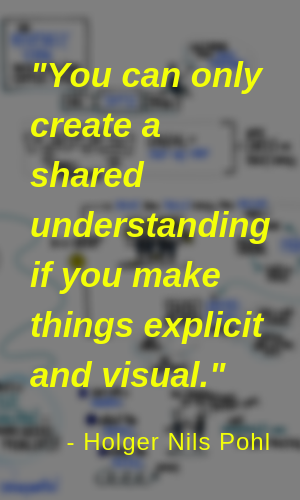 Frey: How can visual tools help with sense-making, clarity and decision making?
Frey: How can visual tools help with sense-making, clarity and decision making?
Pohl: Imagine that situation where you sit down with a colleague, and you try to explain a new idea to her. You talk and gesture and talk. And she is asking the right good questions. But after 15 minutes or so both of you still struggle to get an alignment or to fully understand each other. Frustrated you get a piece of paper, you draw two circles overlapping and point to the intersection saying “This is where we should invest. That’s what I tried to say.” And she says “Oh, yeah! Why didn’t you say that right away?”
It happens to me all the time with my clients. They speak, they argue, and at the moment they make their thoughts visible and tangible, they create alignment and a common understanding. Without visual tools, most complex topics stray very fuzzily.
Frey: How important is it to get clear on the nature of a problem or challenge before we start to brainstorm potential solutions?
Pohl: If you don’t know your goal, you will not get anywhere. It’s as simple as that. And you can’t define a goal if you don’t understand the problem at hand. Do your homework first and understand the problem. Then define your goal. Make clear how you imagine the situation in which you have solved the problem or challenge. And only then start brainstorming potential solutions.
Frey: One of the techniques you talk about in your blog is creating a design brief. How can that help people to reach clarity on a problem or challenge?
Pohl: The concept of the design brief is precisely that tool to understand the problem to the fullest. A professional designer will always come back to force you into a design brief. Because the designer needs all possible information about you, your business, your purpose, your messages, your goals, your audience, your clients and whatnot. Without all those information a designer can’t create an original design that is fitting only you.
The same goes for the design brief of a business problem. If I just ask you to come up with a great business model for my coaching business. What would you develop? An online platform, connected to social media? With a mastermind group to get people into it perhaps? Online training combined with video calls? A YouTube channel with topics my clients would like to see?
But if I show you who I am, what I want to achieve, how I work and what I enjoy you might have way better ideas. You might suggest a once-in-a-year retreat in the woods, with sports programmes attached for a handful, high potential, high achieving individuals who can only book via text message for an insanely high price.
You get the point.
The better you understand the problem and the better your design brief is, the better the solutions will be in the end.
Frey: Does collaboration benefit from visual thinking as well? How can it help teams arrive at a common understanding of the challenges they face?
Pohl: When you put something on the wall, it will create a surface for understanding. The problem in collaboration is not that we are not smart enough. The problem is that we all listen through the filter of our own experiences and our own focus. And an even bigger problem is that our thoughts are intangible. You can’t see my thoughts (yet), and I can’t see yours.
But if we put a visual on the wall both of us have something to see. If you combine the spoken words with something tangible and visible to speak about and to discuss, that elevates a conversation to unknown highs.
And I would go so far as to say that you can only create a shared understanding if you make things explicit and visual.
Frey: I also believe that there’s real power in transmuting your thoughts into tangible form, which enables you to literally “think about your thinking.” How do you view that process of teasing out and refining your own thinking?
Pohl: Sometimes when I sit down to think about a new concept I’m working on I will draw those thoughts. Quite regularly it happens to me, that I just write or draw without any structure or order. Just putting those thoughts on the paper as they come. All of the sudden I see something on the left side that seems to be connected with an element in the middle. And often enough I had never thought about the fact that those two elements are connected with each other! Boom. A new concept is born.
I always say that drawing is a conversation with my thoughts. Sometimes I discover things I didn’t know that I knew them. Often enough I discover flaws in my thinking by putting my thought on paper. In those moments it happens that I write one step of the process I’d like to explore deeper. Then I draw the second step. And I see that they don’t fit. I missed a step I wasn’t even aware of before. Those moments are gold to me.
Frey: What is the focus of your new book, Enabling Clarity?
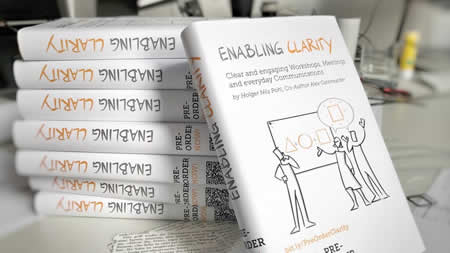 Pohl: Enabling Clarity will be the book where I put down my way of problem-solving and how people can use this in their business as well as facilitating others with it. The book will cover some fundamentals on why we should use visual tools and then deep dive into the Clarity Framework. The Clarity Framework is the process and mental model I use to help myself and my clients solve business challenges or wicked problems.
Pohl: Enabling Clarity will be the book where I put down my way of problem-solving and how people can use this in their business as well as facilitating others with it. The book will cover some fundamentals on why we should use visual tools and then deep dive into the Clarity Framework. The Clarity Framework is the process and mental model I use to help myself and my clients solve business challenges or wicked problems.
It is a pretty straight forward process where you run through three phases of “Understand, Create and Share.”
I will make these steps as easy and applicable as possible in the book. My goal is to create a book that will enable you to integrate this framework into your business and workshop routines without further consulting or training needed. Let’s see how I can make this possible. 😉
Frey: Alex Osterwalder is a pretty heavy hitter in the field of visual thinking, with his business model canvas. How did you two get together?
Pohl: A few years back I helped the founder of stattys.com to get his products to market and build his brand. Alex Osterwalder discovered Stattys and is using them from then on in all his workshops. This connection led to my first graphic recording job in his masterclass in Berlin 2012. I continued working at his masterclasses, we had goods chats and discovered to be like-minded. Now we are very good friends and close business partners.
I think it was just a natural fit as we both are first deeply convinced of the power of visual tools and second know that drawing will not win the game but a practical approach for business people to apply easily.
Frey: What unmet needs did you see that led to the creation of Enabling Clarity?
Pohl: To be honest, it is first and foremost my own need to put my own process and thinking into a tangible form. I needed to get clarity on how I do the things I do, why I do them and especially why I am successful with them.
A book is unforgiving. You need to figure out every detail, and your structure needs to be rock solid. Working on the book already clarified so many things for me I would have never discovered without writing it. I have the feeling that a lot of people will benefit from it as well, but my main focus is to get this clear for myself.
Frey: How would you describe the state of visual thinking and planning in business today? Where has it made progress? Where does it have a long way to go?
Pohl: The progress I see is that more people know about it at least. More and more companies are using visual thinking. And more and more people thrive to make a career in the field of visual thinking. If a market like this is developing quickly with hundreds of new practitioners every year, it’s a good sign that the market is adopting it.
In my personal work with companies and especially with my coaching clients I see more and more high achieving business people adopting the methodology and thinking models. We still have a way to go on two fronts:
First the fame factor. Still, a lot of businesses use visual thinking as a “nice to have.” Something cool. A decoration of sorts. A trend. That’s of course counterproductive. If you don’t learn to use these tools to support your business rather than to be nice and shiny, they will not help you.
Second is resistance. People still fear to take a pen in hand and work on a paper on the wall or the flipchart. “What if I ruin my career by looking silly in front of my colleagues?” Or “I can’t draw pretty.” Or “I don’t have good ideas to contribute.” Or “I don’t have a clue.” you name it. Getting people to build new habits and routines and making them understand what it really means to work visually and use visual tools still is the biggest challenge and still needs to be solved. I hope to help with that with my book, Enabling Clarity.
Frey: What do you wish business people understood about visual thinking?
Pohl: It’s not about drawing. It is about finding ways to make your thought tangible and visual. Nobody said you need to draw something for that.
Your blog here is a good example! A mind map does require zero drawing skills, and yet it is a super powerful visual tool! Do you think that business strategies like Lean and kaizen are starting to open more business peoples’ eyes to what’s possible with visual thinking? Or is it just reinforcing their existing linear thinking mindset?
It is like with all other methodologies and tools. If the experts are teaching them in the right way, all of the methods will lead to more flexible, more agile thinking. If they show them in the wrong direction, they will reinforce old habits in new clothes. Think of those praised methods a second time. What are all of them doing? Trying to help people working better together. That should be the goal anyway. Those methods are just container maintaining to trick people into common sense. And I like that! I support that. I would use any trick I can get to help people working better together.
Frey: What would you say to those people who are on the fence – who are intrigued by the idea of visual thinking, but aren’t sure if it’s right for them?
Pohl: Start small but be consistent. Don’t expect overnight success.
In my blog post, A surprisingly simple way to unlock your most difficult problem (in just 5 minutes!), I describe in the second half how you can create a visual design brief for yourself. You will see it’s more words than drawings. Start playing around with that concept for yourself. Nobody has to see it!
Once you feel like it, perhaps try to clarify a thought with a good friend or colleague in that way. And after you feel more confident, perhaps start testing with more elaborate visual tools.
But please don’t think that you need to able to draw. You just need to be able to get a pen down on paper. The rest will come.
Frey: Where can readers of this blog learn more about your work and how you think?
Pohl: The best place to start is my website holgernilspohl.com. Visit my blog under holgernilspohl.com/blog. The backlist is short, but it grows steadily.
You can find me on social media under my full name @holgernilspohl I’m active on Facebook, LinkedIn, Twitter and Instagram.
Oh, and keep an eye on my upcoming book “Enabling Clarity.” If you want to be first to know when it’s published, you may want to subscribe to my newsletter.

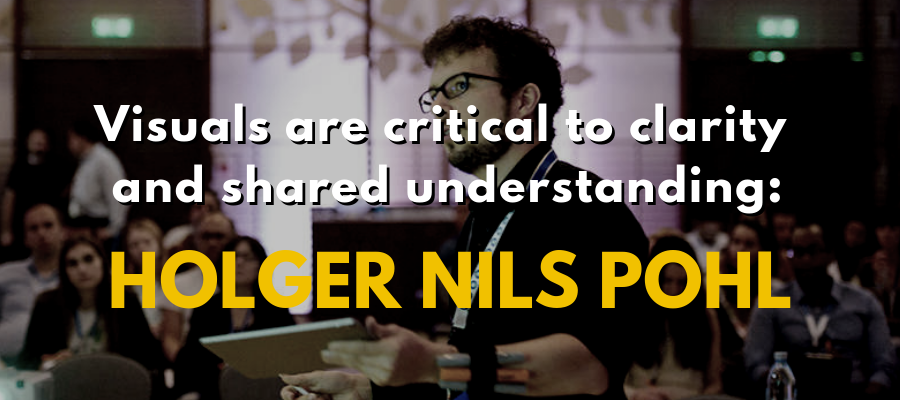
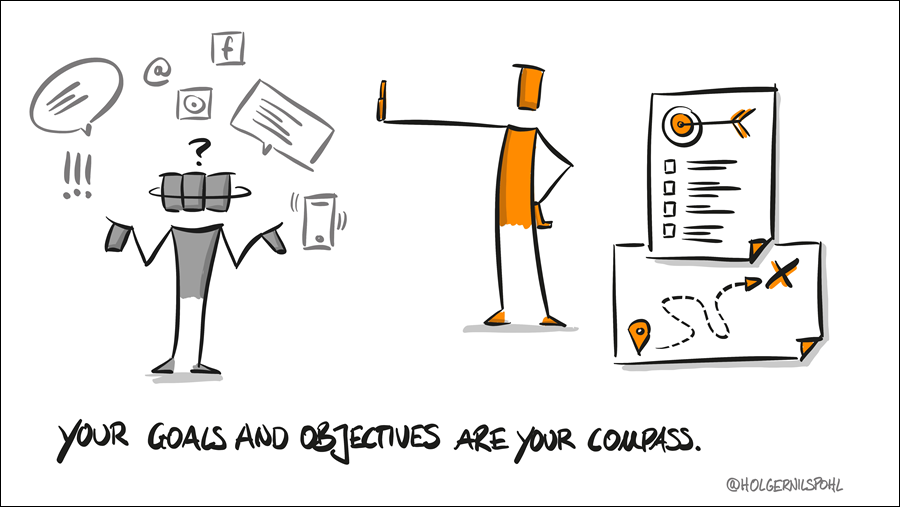
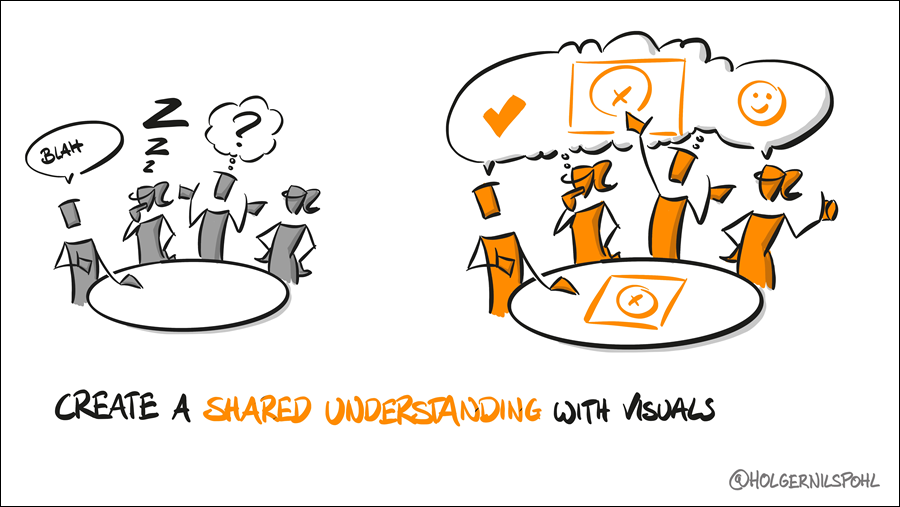
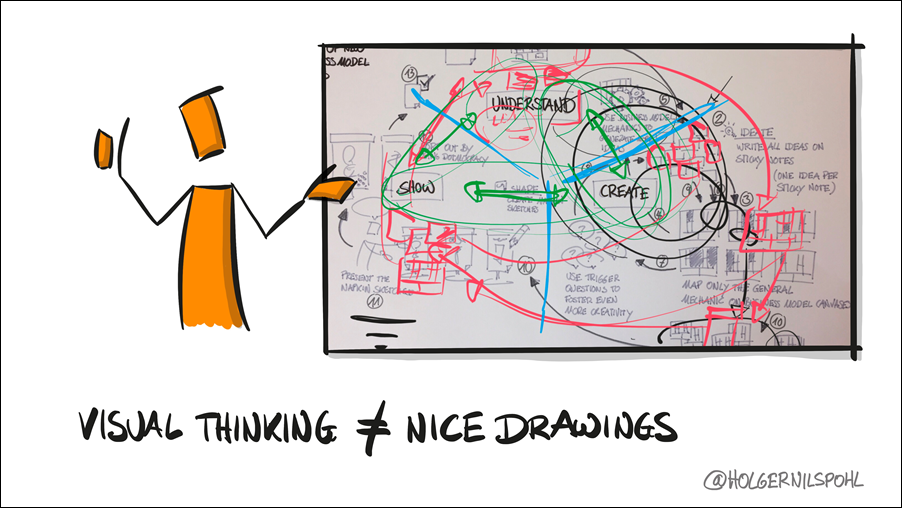
Leave a Reply